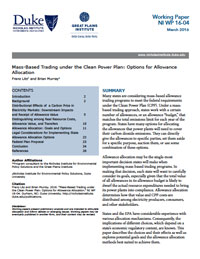Many states are considering mass-based allowance trading programs to meet federal Clean Power Plan (CPP) requirements. Under a mass-based trading approach, states work with a certain number of allowances, or an allowance “budget,” that matches the total emissions limit for each year of the program. States have many options for distributing the allowances that power plants will need to cover their carbon dioxide emissions. They can directly give the allowances to specific parties, set them aside for a specific purpose, auction them, or use some combination of these options. Allowance distribution, more commonly known as “allocation,” may be the single-most important decision states will make when implementing mass-based trading programs. In making that decision, each state will want to carefully consider its goals, especially given that the total value of all allowances in its allowance budget is likely to dwarf the actual resource expenditures needed to bring its power plants into compliance. Allowance allocation determines how that value and CPP costs are distributed among electricity producers, consumers, and other stakeholders. States and the EPA have considerable experience with various allocation mechanisms. Consequently, the implications of different choices, which depend on a state’s economic regulatory context, are known. This paper describes the choices and their effects as well as explores potential goals and the allowance allocation methods best suited to achieve them.
Nicholas Institute for Environmental Policy Solutions
Publisher
Copyright
| Permalink: https://hdl.handle.net/10161/27351

